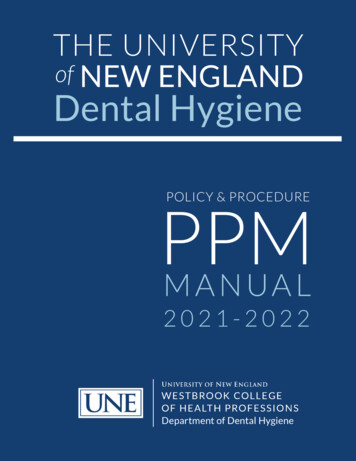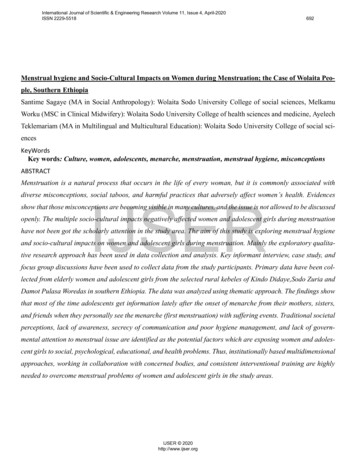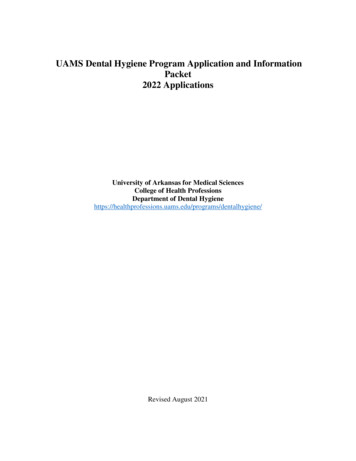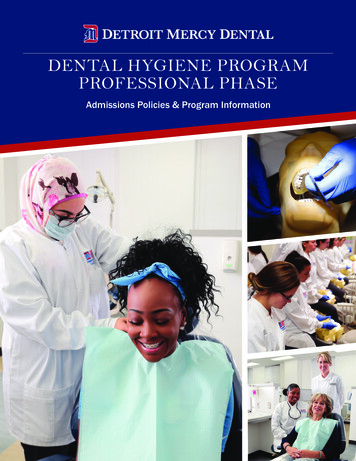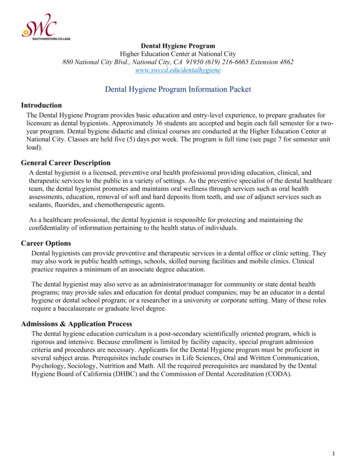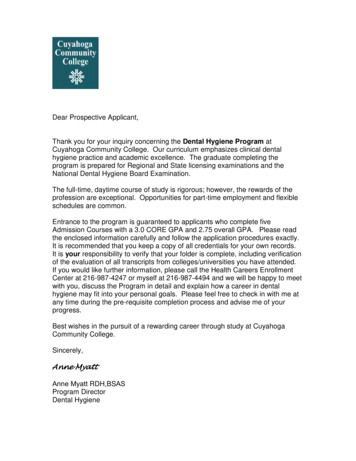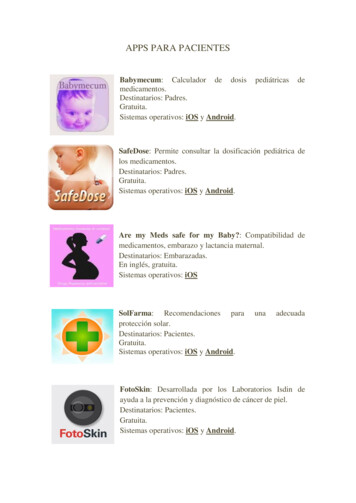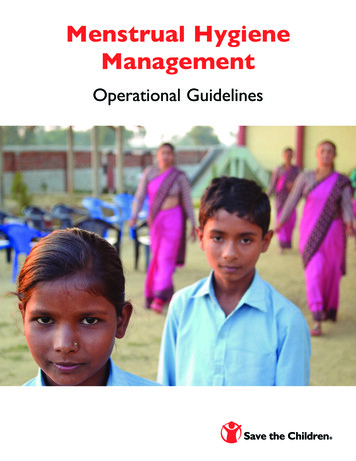
Transcription
Menstrual HygieneManagementOperational Guidelines
AcknowledgementsWe are grateful to all the people and organizations who contributed to the development of the Menstrual HygieneManagement (MHM) Operational Guidelines. Thank you to all our Save the Children colleagues who reviewed drafts ofthe Guidelines and shared supplementary resources for this document: Sarah Bramley, Amy Jo Dowd, Jarret Guajardo,Caroline de Hilari, Christine Jonason, Brad Kerner, Seung Lee, Natalie Roschnik, Ruth Speyer and Mohini Venkatesh.We truly appreciate our external reviewers who volunteered their time to provide feedback on various iterations of theMHM Guidelines: Sue Cavill, UNICEF; Shakil Chowdhury, Save the Children International, Bangladesh; Anna Ellis, EmoryUniversity; Sarah Fry, WASH PLUS/FHI 360; Sarah J. House, Independent Consultant; Audrey Kettaneh and Scott Pulizzi,UNESCO; Elynn Walter, WASH Advocates; and Diego Zendejas, Save the Children Mexico. A special thank you toBethany Caruso, Emory University, Marni Sommer, Columbia University and Robert Dreibelbis, Oklahoma University, forsharing their MHM and research expertise, as well as providing an in-depth review of the document. We also thankSteve Sara, Save the Children, for keeping the piloting process manageable and on track.Finally, this project would not have been a success without our dedicated Save the Children Country Office staff whotook on this additional project and are managing and implementing MHM pilots in their program impact areas:Bangladesh – Nishat Mirza, Nasima Kama and Mostafijur Rahman; Bolivia – Magaly Perez and Rosse Mary Vargas;China – Jinping Guo, Nicole Li and Xiner Xu and Li Zhao; El Salvador – Margarita Franco and Lisseth Monroy;Kenya – Cherio Onacha and Varinia Luveg; Philippines – Jonathan Valdez, Anjelia San Buenaventura,Luisa Dominguez, Melchi Uyasan and Katrina Ajes.The MHM Operational Guidelines were written by Jacquelyn Haver and Jeanne L. Long, Save the Children.This effort was made possible thanks to Sponsorship Innovation Funding from Save the Children, U.S. andSave the Children Italy, as well as funding from the Long Island Council Fund.Contact DetailsSeung Lee, Sr. Director School Health and Nutrition, slee@savechildren.orgJacquelyn Haver, Specialist School Health and Nutrition, jhaver@savechildren.orgJeanne L. Long, Specialist School Health and Nutrition, jlong@savechildren.org
Table of ContentsAcronyms4Introduction to the Menstrual Hygiene Management (MHM) Operational Guidelines5Situation Analysis8Development, Structure and Use6Appendix A: Example Oral Assent Script for Focus Group Discussions with Girls17Appendix C: Menstrual Hygiene, the Basics. An Excerpt from WaterAid’s Menstrual Hygiene Matters20Appendix E: Qualitative & Quantitative Research: Why, How, Proportions, Frequency, Amounts24Appendix B: Critical Steps for an Abbreviated MHM-SHN Integration Program CycleAppendix D: Key Questions for MHM Situation Analysis1822Appendix F: Situation Analysis Community and School Activities25Menstrual Hygiene Management (MHM) Program Design27Appendix H: Example Program Activity Checklist for SHN Program Managers37Appendix G: Example Results Framework36Appendix I: MHM Checklist for Intervention Assessment38Appendix K: Potential Risks to Health of Poor Menstrual41Menstrual Hygiene Management (MHM) Monitoring & Evaluation42Appendix M: Randomly Selecting Students for the KAP55Appendix J: Suggested Scheme for Intermittent Iron and Folic Acid Supplementation in Menstruating WomenAppendix L: Pointers for Designing and Piloting Data Collection ToolsAppendix N: Creative MHM KAP Questions for Basic Facts405356Appendix O: Visual Likert Scale options57References58The front photo cover credit: Jacquelyn HaverThe back photo credit: Lisseth Monroy
AcronymsAD – Adolescent developmentASRH – Adolescent Sexual and Reproductive HealthCASP – Common Approach to Sponsorship-funded ProgramsDM&E – Design, Monitoring & EvaluationERC – Ethics Review CommitteeFGD – Focus Group DiscussionFRESH – Focusing Resources on Effective School HealthIDI – In-Depth InterviewIEC – Information, Education and CommunicationIR – Intermediate ResultIRB – Institutional Review BoardKAP – Knowledge, Attitudes and PracticesKII – Key Informant InterviewM&E – Monitoring & EvaluationMDG – Millennium Development GoalsMEAL – Monitoring, Evaluation, Accountability and LearningMHM – Menstrual Hygiene ManagementMoE – Ministry of EducationMoH – Ministry of HealthNGO – Non-Government OrganizationPTA – Parent Teacher AssociationSCI – Save the Children InternationalSHN – School Health & NutritionSIP – School Improvement PlansSMC – School Management CommitteeTA – Technical Assistance/AdvisorUNICEF – United Nations International Children’s Emergency FundWASH – Water, Sanitation and HygieneWinS – WASH in SchoolsWHO – World Health OrganizationSAVE THE CHILDREN – MENSTRUAL HYGIENE MANAGEMENT OPERATIONAL GUIDELINES4
Introduction to the Menstrual HygieneManagement (MHM) Operational GuidelinesThere is an increase in attention on girls’ education by the global development community. As a result, wehave seen improved retention and grade promotion for girls in many countries. With this progress, we findourselves confronting both new challenges and opportunities for girls to achieve an equitable education.Menstrual hygiene management (MHM) is one among several challenges and opportunities – and it is thefocus of these guidelines.Adolescence and puberty is a time of intense physical and emotional change for young people between theages of 10 and 17. Puberty marks a transition between childhood and adulthood that impacts adolescents’physical, emotional and social wellbeing. Evidence shows that during puberty, adolescents embrace and solidifythe gender norms of their society. So the way girls and boys see themselves within their family, community andsociety can be drastically altered for the rest of their lives.In some contexts, puberty leads to increased social restrictions for girls and increased social freedom for boys.Many adolescents, especially girls, will experience a severe drop in self-confidence during puberty. All of thesefactors, and more, contribute to the increased rates of risky social and health-related behaviors that manyadolescents practice.Interventions that target younger adolescents, before these risky behaviors and norms are fully engrained, aremore effective at mitigating the behaviors and negative health and education outcomes that ensue. At thiscritical and extended juncture in their development, we have the opportunity to empower adolescent boysand girls, support girls’ transition into secondary school and increase girls’ opportunities to learn and thriveinto adulthood.For girls, menarche and menstruation is the physical, highly visible, and at times erratic, marker of this transition.As a result, over the past decade, MHM has gained more attention from researchers and developmentpractitioners. Formative research across the world has shown that girls in low-resource settings face manychallenges managing menstruation in school. These challenges have numerous causes but can includeinadequate water and sanitation facilities at school, limited access to effective, hygienic materials for menstrualmanagement and inaccurate information about menstruation and the biology of puberty. Research-supportedrecommendations have been proposed on how to address these challenges; however, the internationaldevelopment community is lacking proven program interventions. Key MHM stakeholders have come toconsensus that a clearly defined package of evidence-based interventions is required.At this stage of MHM evidence building and with more girls in school than ever, we know girls often lack thetangible and social-emotional support that they need during this critical transition. While we are still evaluatingMHM interventions, we know that comprehensive education and health approaches are always needed. To fullyaddress MHM in schools, practitioners should consider programming that ensures that girls and boys haveaccess to services, a safe and enabling learning environment, skills-based learning and community and policysupport. This document aims to provide in-depth program guidance, using the Focusing Resources on EffectiveSchool Health (FRESH) framework and Save the Children’s Common Approach to Programming, so thatschool health practitioners can incorporate MHM into their programs.While MHM is not different from other school health interventions in its requirement of careful planning andcollaboration, this topic is sensitive and sometimes stigmatized due to the link between menstruation andsexual and reproductive health. It is our responsibility to design, implement and monitor our program toSAVE THE CHILDREN – MENSTRUAL HYGIENE MANAGEMENT OPERATIONAL GUIDELINES5
respect those sensitivities, as well as reduce the social stigma of menstruation and puberty. To do this, the processoften starts by evaluating our own beliefs and biases. In fact, throughout the program cycle steps, staff may encountera stigma towards MHM. There may also be teachers, parents, students and high-ranking officials with negative beliefson MHM, or simply inaccurate information. Throughout the program cycle, program staff should take care not tofurther propagate or reinforce the misinformation along the way.While this document has been written in the context of school health and nutrition, MHM can be integrated withprograms that focus on Water, Sanitation, and Hygiene (WASH) in Schools (WinS), comprehensive sexualityeducation, gender-based violence, gender empowerment and normalization and other adolescent developmentprogramming. MHM interventions should not be implemented in isolation of other programs or of other partners.Research and interventions that aim to change policies and norms should be undertaken in alliance withgovernment, bilateral and Non-Government Organizations (NGO) partners. Making the effort to bring thesepartners and stakeholders in from the beginning will increase the success and sustainability of MHM interventions.Development, Structure and UseThe MHM Operational Guidelines (MHM Guidelines) were reviewed and piloted internally by Save the Childrenand reviewed by external MHM stakeholders. First, Save the Children School Health and Nutrition (SHN) staff wroteeach chapter. The chapters were reviewed by senior SHN advisors and MHM researchers for initial feedback.Feedback was incorporated into a second draft, which was piloted by Save the Children Country Offices inBangladesh, Bolivia, China, El Salvador and the Philippines, with MHM learning activities tested in Kenya.In the first five countries mentioned, the program teams implemented each chapter of the MHM Guidelines andprovided bi-monthly feedback to the SHN U.S. team. Comments were provided regarding the utility of each chapterand the logistical and budget considerations that accompanied the process. Program teams discussed how theguidelines helped them plan and implement, as well as the challenges along the way. Their feedback was integratedinto a third draft of the MHM Guidelines, which were then reviewed by 15 people representing seven organizations,as well as four separate teams within Save the Children.The MHM Guidelines consist of three written chapters with corresponding appendices that provide explicit andcomprehensive guidance on conducting an MHM Situation Analysis, designing an MHM program and monitoring andevaluating an MHM program. The chapters are meant to be read and implemented in that order, with each chapterbuilding on the chapter before it; it is strongly advised to read all three chapters prior to beginning any MHMprogram planning. However, we understand that practitioners may be in varying stages of MHM programming, andif they are not starting a program from scratch, this document can still provide helpful programming tools. Weencourage practitioners to take and apply the parts they find most useful to their context and their program.The MHM Guidelines also contain planning and implementation documents and tools that are not easily accessibleonline, or were developed through the piloting of these guidelines. This includes items like template budgets,consultant terms of reference and MHM Knowledge, Attitude and Practice (KAP) survey questions, as well asqualitative research tools. The MHM Guidelines build on previous fundamental MHM efforts, referencing and linkingto resources produced by UNICEF, WaterAid, the Joint Monitoring Programme, UNESCO, Emory University andothers. Save the Children will provide soft copies of this document to anyone who is interested in using it.SAVE THE CHILDREN – MENSTRUAL HYGIENE MANAGEMENT OPERATIONAL GUIDELINES6
Getting Started: Planning and Financing thedevelopment of your MHM ProgramDevelop a timeline, budget and brief implementation plan for the Situation Analysis, Program Design andM&E planning. Details may shift and evolve over time, but this first part of the program cycle (SituationAnalysis to baseline assessment) typically takes 4-6 months. Tools for planning your budget, timeline andconsultant requirements are in the Planning & Implementation Resources folder on the flash drive.Remember to build in time to obtain relevant local and ethical approvals. Local approval from the Ministry ofEducation, municipal officials and headmasters will be required regardless of whether this is an experimentalstudy or program monitoring; some countries and institutions may require parental consent for minors toparticipate in activities. Other local and international ethical standards may apply.Factors to consider for your budget and timeline include:1.2.Desk review of relevant reports and research.Design of situation analysis and evaluationa.b.c.3.4.5.Non-experimental vs. Quasi-experimental vs. Experimental study designSampling strategies and participant recruitment.Tool developmentd.Informed consent and assenta.StaffingFacilitator and enumerator trainingsb.Hiring external consultants or evaluatorsData management, monitoring and analysisFeedback to participants and key stakeholders after each program step.SAVE THE CHILDREN – MENSTRUAL HYGIENE MANAGEMENT OPERATIONAL GUIDELINES7
Menstrual Hygiene Management (MHM)Situation AnalysisBefore implementing an MHM program it is important to develop an understanding of the problem, theneeds, and influencing factors that could potentially affect your program.Goal of this step:Identify the status, problems and needs in the impact (program) area to inform Program Design. Overarchingthemes to investigate include: Existence and availability of school and community WASH infrastructureExistence and availability of health services, such as health posts or community health workers, anddetermine if they facilitate positive knowledge and practices for MHMKnowledge, attitudes and beliefs surrounding menstrual hygiene for pre-adolescent girls and boys,adolescent girls and boys, parents, teachers and the communityAvailability and access to hygienic menstrual management materials in school and the communityCurrent policies and advocacy efforts surrounding menstrual hygieneThis chapter includes the following sections:1. Purpose of including MHM as a Part of a SHN Situation Analysis2. How to Conduct a Situation Analysis in Seven Steps3. Appendices A - FWhat you will need: This Menstrual Hygiene Management (MHM) Situation Analysis Module The WASH in Schools Empowers Girls’ Education: Tools for Assessing Menstrual HygieneManagement in Schools2 (located in the Planning & Implementation Resource folder on flash drive)The 2010 School Health & Nutrition (SHN) Common Approach to Sponsorship Programming(CASP) module1 (Document #1 in the Planning & Implementation Resources folder on the flash drive)The outputs of this step will be: A set of adapted MHM tools to collect Situation Analysis dataA Situation Analysis report that will be used to inform an MHM Program DesignSharing results of Situation Analysis with community stakeholdersSAVE THE CHILDREN – MENSTRUAL HYGIENE MANAGEMENT OPERATIONAL GUIDELINES8
1. The Purpose of Including MHM as a Part of a SHNSituation AnalysisIn nearly every country, an increasing number of girls are attending primary school and then continuing on tosecondary school.3 The global community’s successes in primary education has led to a greater focus onaddressing barriers to girls’ attendance, quality of educational experience and completion of secondary school.Adolescent girls face numerous barriers to continuing their education related to the onset of menses, as manygirls receive little to no information concerning puberty, the biology of menstruation or hygienic methods tomanage menstruation. As a result, many are uncomfortable, insecure and ashamed to manage theirmenstruation (see Appendix C for Menstrual Hygiene, the Basics).4At school, girls may face an unsupportive social and physical environment, where there is also insufficient water,sanitation and hygiene (WASH) facilities to properly manage menses or proper student/teacher codes ofconduct to protect girls from bullying and teasing. They may also lack access to proper menstrual managementmaterials.5-10When girls experience menstruation without adequate facilities, information or materials to manage theirmenses at school, they may become distracted and unable to concentrate.8-17 As a result, girls may stopparticipating in class, isolate themselves or become socially excluded by peers. Some may even skip schoolaltogether.To address MHM challenges that inhibit girls’ educational experience, we need to create an enabling learningand community environment where girls feel confident to participate in school during their menstrual cycle andare able to keep their dignity intact.Many of the existing SHN strategies impact MHM and are already a fundamental component of SHNprogramming. Each Focusing Resources on Effective School Health (FRESH) pillar has key strategies thatdirectly relate to MHM programming (SHN CASP, p. 50). For example, Intermediate Result (IR) Two calls for theimproved quality of the school environment. Typical activities for IR Two include provision of appropriate handwashing facilities, separate child-friendly and sanitary latrines for girls and boys and solid waste and environmentmanagement. However, during assessments and program planning, how girls interface with the WASHenvironment when they menstruate is not fully examined and applied when designing programs. WASHinfrastructure is not the only example of MHM and SHN program overlap, but is one component that mayhelp to ensure that girls’ and boys’ school experiences are more equitable.A Situation Analysis will help us understand the context, cultural attitudes and traditional practices of puberty,menstruation and MHM in the impact area so that interventions are meaningful and positively impact girls.2. How to Conduct a Situation AnalysisAs stated in the SHN-CASP module, the goal of a Situation Analysis is to “identify problems and needs in theimpact area to inform Program Design.” Please review pages 17-20 from the SHN-CASP module forinformation on how to conduct a Situation Analysis. Below we provide information for each step that isspecific for the MHM portion of a Situation Analysis. (More details about each step listed below are included inthe appendices and the Planning & Implementation Resources folder on the MHM Operations Guidelines flash drive.Operational limitations may require an abbreviated process to integrate MHM into SHN programs. For critical stepsfor MHM-SHN integration, see Appendix B: Critical Steps for an Abbreviated MHM-SHN Integration Program Cycle.)SAVE THE CHILDREN – MENSTRUAL HYGIENE MANAGEMENT OPERATIONAL GUIDELINES9
Step 1: Plan the Logistics of Your Situation Analysis.Refer to the steps on page 7, Getting Started: Planning and Financing the development of your MHM Program.Ensure that all relevant ethical approvals and protocol are in the pipeline prior to data collection activities.Step 2: Review the Questions in Appendix D: Key Questions for MHM SituationAnalysis.An MHM Situation Analysis is typically integrated within a larger SHN or Adolescent Development (AD)program, so Key Questions should be pulled from WASH in Schools Empowers Girls Education Tool Kit andfrom SHN or AD sections of the SHN-CASP module. Secondary and primary data should be collected forthe Situation Analysis.Step 3: Conduct Desk Review.Though formative research has been conducted in many countries, it may be difficult finding nationally orregionally representative MHM data. You may need to examine studies in your region, or among similarpopulations (religious, ethnic, etc.). Coordinate with local Non-Government Organizations (NGOs) andagencies to understand what information or studies are underway. Information on WASH, sexual andreproductive health, gender and child protection can also help us make inferences about the potential needs,challenges and sensitivities surrounding MHM (see Appendix D for more information on secondary data collectionand refer to resources listed on page 18 of the SHN-CASP module).Step 4: Preparation for Primary Data Collection.Discussions with various groups and individuals at the local and community level should occur in order tounderstand the diverse perspectives of MHM. Use qualitative tool guides to conduct focus group discussions(FGD), in-depth interviews (IDIs) and key informant interviews (KIIs). To do this, adapt existing tool guidesprior to conducting Situation Analysis activities. Examples of generic tools for girls, boys, parents and schoolstaff are available through the WASH in Schools Empowers Girls Education Tool Kit. Assistance from an SHNor AD Technical Assistance/Advisor (TA), or an expert in this field, is strongly recommended during this stage.Consider contacting other NGOs to identify surveys or tools that have been used in your country and arecontextually relevant.Menstrual hygiene may be a taboo topic in a community. People may hesitate to speak openly about practicesand beliefs that are private or that they do not understand well themselves. These challenges can hinder datacollection. For this reason, during tool adaptation and MHM training, it is beneficial to include a gender and/orchild protection advisor in discussions to provide additional context and to assist in identifying potentialchallenges discussing MHM with girls and communities. Qualitative data collection and participatory methodsare the preferred method when little information is known on a subject. Qualitative methods permitfacilitators to ask “which” behaviors exist and “why” people practice them, which are important questionswhen designing a contextually relevant school health MHM intervention. (For more information on qualitativeand quantitative research, see Appendix E.)Staff may also give a brief two-to-three day training for data collectors and facilitators prior to holding schooland community discussions. Training should prepare them to (1) discuss sensitive topics with children andcommunities; (2) understand and apply research ethics and protocols; (3) present basic information aboutmenstrual hygiene; (4) have all data collectors review tools and consent forms; (5) practice conductinginterviews and focus groups (pilot); and (6) collect feedback from research assistants on effectiveness of thetools to engage participants and then adapt the MHM tools based on the feedback.SAVE THE CHILDREN – MENSTRUAL HYGIENE MANAGEMENT OPERATIONAL GUIDELINES10
The main data sources include: FGDs and IDIs: The main data collection method will be adolescent girl FGDs and IDIs. It is important todiscuss the topic with other community members, including mothers, men and boys. What men and boysbelieve about menstruation is an integral piece of designing an MHM program.KIIs: Key Informants provide additional access to information and/or populations and are importantfor building local relationships. KIIs are usually conducted with school staff, community leaders, healthextension workers and local government health and education officials.WASH facility observation survey: If WASH facility observations have already been conducted for aprevious project, review findings from the assessment. Then compare the observation survey questions withthose in the WASH in Schools Empowers Girls Education Tool Kit and add on MHM-related questions, ifnecessary. The WASH environment is a critical factor impacting MHM programming. WASH observationsshould be done for school WASH facilities to assess the functionality, accessibility and condition of facilities tobetter understand if facilities enable girls to manage menstruation. There may be WASH tools specific to thecountry – so it is important to check in with the government and/or the UNICEF WASH desk.Tools should be piloted in one school to ensure that they adequately collect the information required and datacollectors can apply their training. Below are key tool adaption and implementation principals: Consider using only female facilitators for all activities with girls, and women and male facilitators foractivities with men and boys.Select facilitators who are experienced interacting with children and are comfortable speaking aboutsensitive topics.Include a statement at the beginning of the activity guide that ensures participant privacy and anonymity,as well as explains that all participation is voluntary. See Appendix A. Explain to participants that theyshould keep the conversation private and that each participant and facilitator agrees not to reveal theidentity of others or what they said with their friends, teachers or parents. Participants should understandthat all activities are voluntary. They have the right to withdraw at any time, or simply not answer questions.Use local language and local terminology in the tools. It is important to ask participants whichlanguage they are most comfortable discussing the topic. Facilitators then should be able to speak thelocal language and move between languages during FGDs. If there are well-known terms for“menstruation” or other body parts, use those words throughout the activity.Ensure that questions and their answers will touch on all four FRESH pillars: Access, SafeEnvironment, Skills-based Education and Community Support.SAVE THE CHILDREN – MENSTRUAL HYGIENE MANAGEMENT OPERATIONAL GUIDELINES11
Design FGDs and IDI guides to ease into sensitive questions. Questions should start with general, butrelevant, topics that girls and boys can easily discuss, such as favorite classes, school bathrooms, etc. Thenquestions should progress into the MHM questions. Questions should go from broad, to narrow, tobroad again. And the end of the discussion or interview should end on a lighter note. For example:Introductions:General:“What is your favorite class at school?”“What are the bathrooms like at your school?”General MHM:“What words do people use to talk about menstruation?”Recommendations:“How can parents, teachers and other students help improve schools forgirls who are menstruating?”Key/Sensitive MHM: “How does Rosita feel when she realizes she has stained her uniform?”To see example FGD and IDI guides for primary data collection, refer to WASH in Schools Empowers GirlsEducation Tool Kit. If conducting IDIs with minors, talk to your program manager and TA regarding the best way to protectthe privacy of the interviewee during discussions, while abiding by the Child Safeguarding policy. Anexample solution for one-on-one interviews is to have the adult and child in a location that is visible toothers, but where students and adults cannot overhear the conversation.Focus group discussions and interviews should last between 45 and 90 minutes. Adjust guides so thatyou are not asking excess questions. In general, FGDs should have between 15 and 20 questions, andIDIs should have between 20 and 25 questions. If FGDs and IDIs are ending in under 45 minutes, likelyyou are not getting enough in-depth information from participants and you should ensure that thefacilitator is adequately engaging and probing on questions. Activities that take longer than 90 minutesmay lead to participant fatigue.Make it fun! Think of creative ways to engage girls and boys – make the FGD a game, includeopportunities to brainstorm, write, draw, role play or small group work, etc.Track how well the tools worked. Decide what questions need to be changed, or adapted, whenusing the tools for the rest of the Situation Analysis activities. The Example Question Critique Guide(#9 in the Planning & Implementation folder) is an example of what could be used to correct issueswith the interview or streamline the tool.Planning for ethical considerations General ethical considerations Ensure that the participant or his/her parents provide assent, or consent, to discuss the topic(See Appendix A. for example oral assent script).Conduct the discussion in a private, discrete and safe setting so other people cannot hear.Prior to the discussion, confirm anonymity and that their responses will not be shared withothers or impact their grades in any way.SAVE THE CHILDREN – MENSTRUAL HYGIENE MANAGEMENT OPERATIONAL GUIDELINES12
Guidance on ethical research conduct Engage appropriate enumerators/facilitators; female arepreferable when discussing MHM.Understand background information on menstruation, itsimplications for health and education, the social contextand best practices for improving MHM.Brainstorm among facilitators and teams to understandpotential cultural norms, taboos and the implications forMHM.When forming FGD groups, make participants as similaras possible; always separate male and female participants,keep them in the same age range and from the samecommunities. Do not mix urban and rural or secondaryand primary age participants.Determine whether basic MHM
SAVE THE CHILDREN – MENSTRUAL HYGIENE MANAGEMENT OPERATIONAL GUIDELINES 5 There is an increase in attention on girls’ education by the global development community. As a result, we have s


